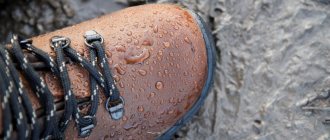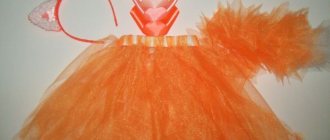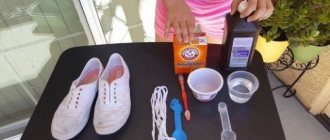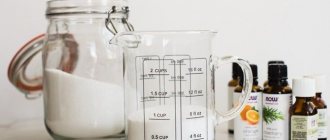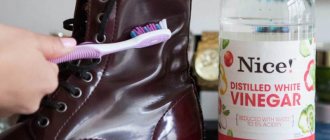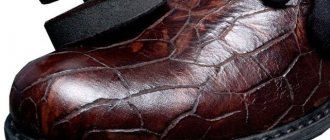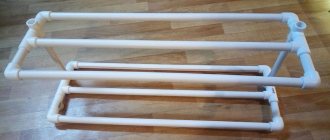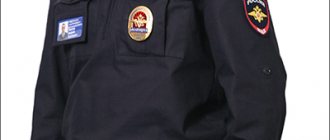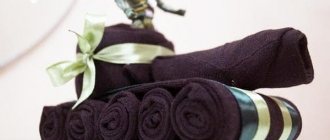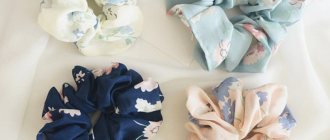Nubuck is a popular leather for making shoes. But if the product is made from untreated material, it is important to know what water-repellent impregnation for nubuck shoes is, how to make it correctly with your own hands and how to apply it correctly. There are industrial varieties of this material, which are saturated with a fatty solution, nubuck oil, but the true, fine-grained variety looks much more impressive, looking like suede.
Shoes worn in the wet season should be warm and not wet. One hour in damp boots - a cold is guaranteed. Even if moisture does not penetrate through, but whitish salt stains appear on the leather surface before the morning, it needs protection, otherwise over time the material will become rough from the salt, deformed and quickly fail. Impregnation will prepare your boots for heavy puddles and will extend their service life.
DIY water-repellent impregnation for shoes
DIY water-repellent mixture for shoes is not at all difficult to make at home. All ingredients for preparing a waterproof product will be natural.
Protection from moisture is needed not only for winter shoes, but also for summer, spring and autumn. A home remedy is no worse than a store-bought water-repellent spray, which is so necessary in any season of the year.
This impregnation will make any pair waterproof and protect against moisture and damage. Natural ingredients - linseed and castor oil - will not only protect against dampness, but also increase the wear life.
Preparing the product is not at all difficult, I think you can find white paraffin candles at home, castor and linseed oil can be bought at a pharmacy or store. To prepare a water repellent we will need:
- Castor oil (2 teaspoons).
- Flaxseed oil (2 teaspoons).
- Paraffin (1 teaspoon, grated candle).
The remaining linseed oil after the shoes have been impregnated with oils and paraffin will be beneficial for health. Flaxseed oil has a rich chemical composition and nutritional value; you can read about its beneficial properties in this article.
Flaxseed oil is good not only for shoes, but also for health, especially women's. It is also used for cosmetic purposes to improve facial skin, so the oil will not go to waste if a certain amount remains.
The remaining castor oil can be used as a natural remedy for hair and eyelash growth. Castor oil and onion hair masks will benefit your hair and make it thick and shiny. I wrote earlier how to make a castor oil mask with onion for hair.
Why do boots get wet in winter?
- The sole has come off. Most often, such a “wet matter” is associated precisely with damage to the sole or its poor-quality “adhesion” to the boot itself.
- Poorly made shoes. Cheap boots “2 pairs for the price of 1” are always of poor quality. Manufacturers use low-quality materials, and the production process leaves much to be desired. Considering that suede and leather themselves do not allow moisture to pass through, we can confidently talk about poor-quality seams or the presence of holes and cracks.
- Chemical reagents. They are used to sprinkle roads in the winter, and it’s no secret that such products can “kill” even the strongest boots in one winter.
- Lack of special impregnation on shoes (note: the manufacturer’s task).
- Synthetic materials. Frost causes artificial leather and other synthetic materials to crack, as a result of which shoes also lose their “moisture resistance.”
The process of preparing impregnation for shoes
The main thing when preparing impregnation is to follow the sequence of actions. Making water-repellent impregnation for shoes at home will take very little time.
I have candles of different colors at home, but for the product we only use white candles without colored dye. We grate them on a fine grater and get paraffin crumbs, which we need one teaspoon.
Pour castor and linseed oil into a bowl, add paraffin, stir until completely dissolved, and then heat the mixture in a steam bath. The resulting liquid is cooled to a warm state. Next, pour the resulting mass into a prepared jar, for example, a baby food jar, an empty cream jar, or any other container.
Video material
Please note that water-repellent treatments for leather shoes are not suitable for suede boots. Fats and oils contained in the products negatively affect the suede fibers. This spoils the appearance of the boots. For suede you need to buy special products. Water repellents are often available in spray form. This allows them to be applied more simply and efficiently. Remember, the right product will allow you to save both your shoes and your health.
How to properly apply impregnation to shoes
How to apply impregnation correctly so that it is beneficial and has waterproof properties? Before treating shoes, wash and dry them. First I clean off the dirt with a dry brush and use an old toothbrush to clean the soles.
I don’t throw away used toothbrushes; they are useful not only for cleaning shoe welts well, but also for helping with many other household chores. For example, I use them to paint hard-to-reach places in radiators or to clean narrow sliding glass areas on a loggia.
I wipe the top and bottom of the shoes, seams, and shoe welts with a damp cloth or foam sponge slightly moistened in a solution of laundry soap. Then I let it dry before the next step of processing with the impregnation I prepared myself.
Before applying the prepared product, I will run a stream of hot air from a hairdryer over the entire surface of my boots. This is necessary for better absorption and formation of a protective layer on the shoes.
To impregnate shoes, I take a cotton pad and apply a thick layer of thick cream onto my shoe; don’t be afraid that it will turn white and leave marks. To ensure that no stains remain from the impregnation, you need to dry the surface of the shoes again with a hairdryer. A warm stream of air is needed to better absorb the homemade mixture.
I leave the pair for 7-8 hours to absorb the shoe impregnation mixture. I do not recommend going outside immediately after applying the protective waterproof layer. Now I need to check how the universal shoe polish I prepared myself will behave if I pour a glass of water on my shoe. The experiment was a success, I see droplets of liquid flowing from my shoe.
I usually do the processing in the evening, and in the morning my favorite boots are ready for a walk in rainy weather and slush. Feet will be dry unless you deliberately wander through deep puddles. Then your feet will definitely get wet, and no amount of soaking will help.
It is necessary to apply impregnation for shoes every time before going outside again. This is necessary so that the protection of shoes from water is more effective. Prices for ingredients for homemade waterproof impregnation of shoes are as follows: linseed oil (2 tsp, 15 rubles), castor oil (2 tsp, 1 rub. ), paraffin (1 tsp, 2 rubles), total 18 rubles.
The castor and linseed oil left over from preparing the impregnation will not be wasted. Self-prepared impregnation for shoes cost me less than industrial means for getting wet; it does not contain chemicals.
By treating shoes in this way, we not only keep our feet dry, but also increase their wear resistance. This wonderful folk recipe will not let you down - your feet will always be dry, and your boots will delight you with their beautiful appearance.
Prepare your first pair for winter with the help of simple tips and specialists from a shoe workshop:
- We evaluate the integrity of the sole, seams, leather and accessories.
- We wash and clean the surface.
- We change heels (if necessary) and strengthen the heels.
- We sew (strengthen) the seams.
- Reinforce (if necessary) the sole. This preventive measure will help compact the sole, protect it from rapid abrasion and provide anti-slip properties. It is important to ensure that the master uses only high-quality material that will be resistant to reagents and frost. For example, wear-resistant rubber or polyurethane. Such a budget option as resit (note – and microporous rubber) should be abandoned.
Application area
Fire-resistant impregnations are mainly used to treat the workwear of firefighters, workers, metallurgists and representatives of other hazardous professions. But the scope of application of water-repellent agents is wider, and they are used for processing:
- protective clothing;
- jacket fabric;
- tents;
- backpacks and bags;
- belts;
- furniture;
- tablecloths;
- awnings and canopies for the street;
- raincoats.
Water impregnation not only retains moisture, but is also dirt-repellent. Most light and medium dirt is not a problem for such material, since dirt, consisting of large molecules, is not absorbed into the fibers and is easily cleaned off.
You can also...
- Impregnate poor-quality seams with a special agent with water-repellent properties. True, this manipulation will have to be repeated periodically.
- Dry the cracks and holes (note - sand the surface, and then apply drying oil and wait for it to dry).
- Install outsoles (rolling) on top of your sole if you do not want to change it completely.
- Buy fat-containing (nutrient) products for leather shoes. They will restore elasticity to the boots and prevent cracking.
- Buy creams/aerosols based on beeswax for patent leather shoes.
- Find special products for shoes with breathable membranes. Such products will enhance the water-repellent effect and support pore breathing.
What is waterproof
The word “waterproof” translated from English is more of a concept than a simple definition. The situation looks approximately the same as with the word “Xerox”, when in literal translation it is just the name of the company, but the practice has developed when this word is understood as any copying machine. And even a verb appeared - to photocopy, that is, to copy. Same here: Waterproof - adjective: waterproof, waterproof, waterproof. Waterproof - noun: a waterproof cloak (cloak) like a Mackintosh. Waterproof - verb: to make waterproof.
Source
Adhesive and casein waterproof formulations
- Prepare three solutions (50g of fish glue in hot water; 10g of alum in 0.3 liters of H₂O; and grams of white soap in 0.15-0.20 liters) and mix together. Apply the heated mixture to the fabric with a rag or brush. For clothing, you can take equal parts of all three ingredients. This composition is applied from the inside until the outside becomes wet.
- Dissolve 40g of alum, 20g of fish glue and 10g of white soap in 1 liter of H₂O, wet the cloth, squeeze and rinse in a four percent solution of lead acetate.
- To a mixture of 500g of milk casein, 12g of slaked lime and 0.5l of water, add a hot aqueous solution of 25g of neutral soap per 3l. The fabric must be thoroughly soaked in this liquid, dried, then placed for a while in a 2% aqueous solution of aluminum acetate (2 grams per 0.1 liter). Take it out, then put it in boiling water and then dry it.
- Soak the fabric in a hot aqueous solution consisting of 100 g of wood glue, 10 g of acetic acid, 10 g of potassium dihydroxide, per 0.9 liters of hot water. Dry without wringing.
How to soak a tent to prevent water from leaking
I came across 2 recipes on the Internet: 1. Take transparent plumbing silicone sealant, squeeze it into a container with gasoline, leave it for a day to swell and dissolve. Then mix thoroughly and paint the inside of the tent awning with the resulting suspension, dry well in the open air. 2. Take PVC glue, add a heat stabilizer-hardener to it, dilute it with acetone to the required fluidity, then proceed as in the first recipe.
One thing that confuses me is that there is some feeling that these tips come from “armchair theorists.” Has anyone tried to actually apply something like this?
In general, I will be grateful for any useful comments and advice.
Okay, since there’s nothing to lose anyway, I’ll try to paint the small one with PVC glue first. What if a miracle is possible?
Are the tents good? Duralumin? You can choose an awning from the Chinese according to size (you can even use single-layer ones), by the fall sales will begin; they will be 1-2 thousand rubles each. drain and save time and money.
I currently have a tent purchased from Decathlon. Quesha kopeck piece - I don’t remember the model. Costs 1300 or 1200. Made carefully - no problems. I’ve been using it for three years now, and the price in the store is still the same. Why all these experiments with impregnation of old junk? To expect a surprise at every exit - which side was not coated enough and it started leaking?
Rain protection - Protects against drizzling rain (polyester roof fabric with 120 g/m polyurethane impregnation) - The seams are not sealed. The tent is not completely sealed. It turns out just a rag from the sun and wind. Here is a more expensive option, for 1499 rubles. A small two-room apartment with a size of 150*210cm. Weight: 3.4 kg. In principle, the weight is nothing, just right for a tarpaulin tent, although the age of tarpaulin tents seems to be over. Arcs - Arcs made of fiberglass with a diameter of 7.9 mm, well, thank you, at least they didn’t make steel ones. Pegs - Galvanized steel with a diameter of 5 mm for very good bending resistance. and here comes the steel, it turns out that no one bends the pegs; for especially healthy tourists, they probably put in tens of reinforcements so that they don’t bend or break. Waterproof properties: Tested in the laboratory (under 200 liters of water/hour/m) and in real conditions What an interesting characteristic, 200 liters of water, everyone writes the characteristics of the fabric in millimeters of water, but Decathlon has its own measure, in liters-hour, and then in millimeters it turns out to be a completely lousy value, but it’s a lot, as much as 200 liters, and even in real conditions. And don’t even think about such a thing as a mosquito net, it’s already a luxury. Miracles don’t happen, for 1300 rubles you will get a tent. In order to expect a surprise at every outing, it’s easier to take polyethylene instead, at least it won’t leak. https://www.decathlon.ru/RU/product_8056073-36432390/ https://www.decathlon.ru/RU/product_2859520-22083588/#
There are a lot of lyrics and attempts to find and play out humor in the descriptions compiled by store managers. Now to the point - the tent is the most ordinary - both branded brands, such as Alexika, etc., and completely no-name ones have them. They are all made approximately the same. Quesha is a normal mid-ranger between them. The idea that “just a piece of polyethylene is better” is complete nonsense. What is the point of commenting on the pegs is completely unclear. Now I looked - they are made of galvanized rod with a diameter of 3 mm, not 5. I sharpened them with sandpaper additionally - they have no other shortcomings. Regarding protection from rain, it is the same whether it’s drizzling or heavy. In three years I was successfully convinced. Fiberglass arches - again, I don’t understand what the claims are for them in this price category? For 1300 should there be a different material? In general, for your money it’s ok. Although the majors probably need something more glamorous and branded - I don’t argue with that
Maybe read less descriptions on websites, and use more equipment in real conditions, and not in an apartment?
Source
